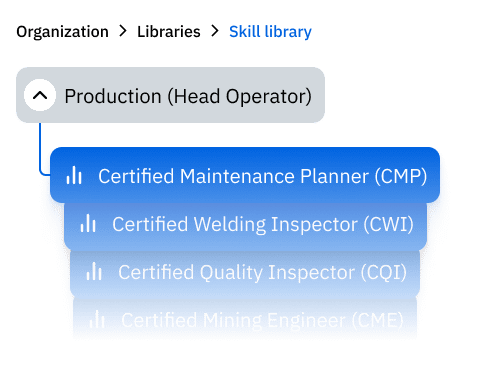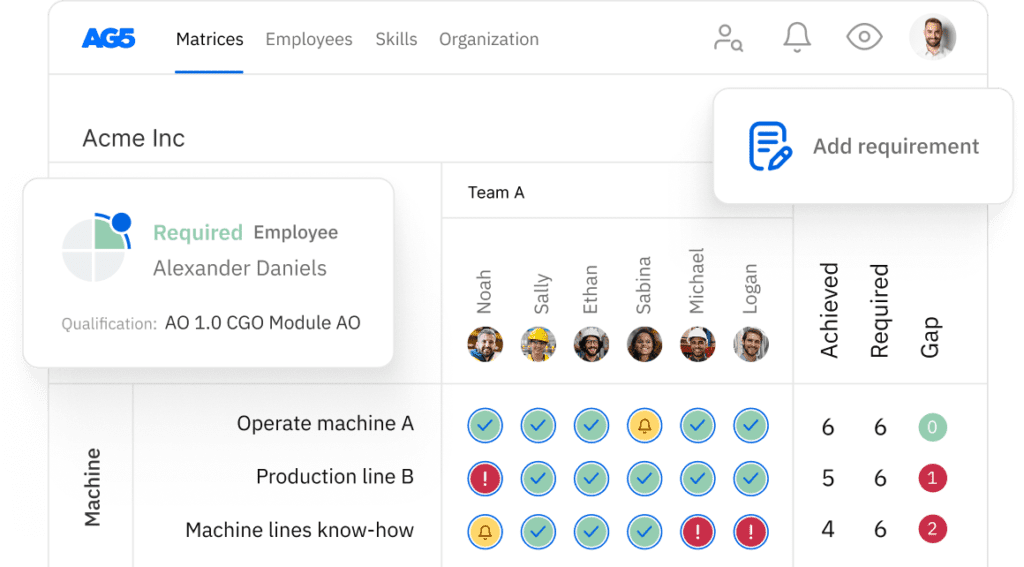Creating a skills library for your organization
Want to understand what a skills library is, why it’s essential, and how to create one? In this article, you’ll learn all of the above, plus get an inside look at how AG5 can help you build the best skills library possible

Without a method of organizing, categorizing, and analyzing your workforce’s skills, you will be in the dark when it comes to skills management. This means you need a skills library.
In this article, we’ll take a look at everything you need to know, including the definition of a skills library, its purpose and benefits, how to create one – and how AG5 can help.
What is a skills library?Copied
A skills library is an online repository that catalogs and organizes the various skills and competencies within your organization.
A skills library serves as a centralized framework that helps managers and team leaders identify, assess, and develop employee skills, as well as aligning them with the goals of the organization.
The purpose of a skills libraryCopied
A skills library helps you define and build a common language and framework for the skills your employees possess and need. So why is this beneficial?
According to Deloitte, skills, rather than job roles, are becoming increasingly valuable, with skill-based organizations reporting higher rates of efficiency, employee engagement, and talent retention. However, only 10% of business leaders are able to classify and organize skills in a way that has a measurable and beneficial impact. [1]
A well-structured skills library addresses this gap by:
- Standardizing skill names and definitions. Creating a unified understanding of various skills across departments
- Identifying skill gaps. By mapping current employee skills against organizational needs
- Helping with talent and resource allocation. Aligning employee skills with project requirements
- Supporting strategic planning. Informing data-driven decisions related to training, succession planning, and employee development
The benefits of a skills libraryCopied
When effectively implemented, skills libraries provide organizations, departments, and teams with a host of benefits. Let’s take a look.
Enhanced agility
Because they can access and analyze skills data of employees across the entire organization, business leaders can react more quickly to changes by distributing skilled employees when and where necessary.
For example, if a manufacturing plant experiences a sudden increase in demand for a specific product, managers can quickly reallocate trained machine operators or assembly line workers from other departments to meet production targets.
Improved talent management
A clear view of employee skills and competencies helps organizations develop better recruitment plans, conduct more thorough performance evaluations, and enhance employees’ career development.
An example here would be tracking forklift operators’ certifications and performance, in turn allowing managers to identify top performers for supervisory roles, schedule safety training for those who require it, and ensure compliance with regulatory standards.
Increased employee engagement
Employees are more likely to feel valued and motivated when their skills are recognized and utilized appropriately. [3] Because a skills library provides visibility into each worker’s expertise – and to continue with manufacturing industry examples – you could assign experienced welders to specialized fabrication tasks, resulting in both higher-quality output and employees who are more satisfied with their roles.
Higher rates of diversity and equity
A skills-based approach to the workforce helps promote diversity and equity in the workplace. In a survey, 75% of executives stated that hiring and promoting employees based on their skill sets helps create equal, more democratic opportunity for roles throughout the organization. [2]
How to create a skills libraryCopied
You can follow the following steps to create a skills library for your teams, departments, specific sites or entire organization. You can use software like Excel for this, however as your skills library – and skills management strategy – grows and evolves, you may want to consider migrating to skills management software.
- Define key skills. Identify the essential skills and competencies your employees need. To do so, you might need to look at job descriptions, meet with department heads, and compare your findings with industry standards.
- Develop a skills taxonomy. Organize identified skills into categories and subcategories – into what is known as a skills taxonomy – creating a hierarchical structure that reflects the organization’s functions and strategic goals. Deloitte describes a skills taxonomy as a system that classifies skills across the company into groups and clusters, serving as the hub of a skills-based organization.
- Assess current skills. Conduct a skills inventory assessment to determine the existing skill levels of your employees
- Establish proficiency levels. Define clear criteria for different levels of expertise to standardize evaluations and development plans. You can read more about how to create a competency proficiency scale in this article.
- Integrate with HR, learning and training systems. Embed your skills library into your organization’s HR and LMS, as well as any training or development software you might currently be using.
- Regularly update. Consistently review and update your skills library to reflect new technologies, processes, and goals. This will ensure your skills library is as current and effective as possible.
Creating a skills library with AG5Copied
AG5’s skills management software comes with a skills library functionality, that helps you create a customized skills library based on your exact needs. Once built, you can use it alongside AG5’s numerous skills management-enhancing features, such as:
- Easy-to-build skills matrices. Create tailored skills matrices in just two clicks, helping you put your skills library to use immediately. Additionally, you can use one of our many Excel-based, industry-specific skills matrix template
- Real-time skill tracking. Dashboards and reports that provide up-to-date insights into employee skills and competencies
- Integration with Learning Management Systems. Seamless connection to your existing software applications helps you quickly close the skill gaps you identify
- Compliance management. In addition to skills, you can use AG5 to track and monitor certification statuses, ensuring you stay compliant with regulatory standards, keep the workplace safe, and keep operations running
Want to see for yourself? Sign up for a free, live, 15-minute demo for a customized look at how AG5 can help you build, use, and update a comprehensive skills library for your entire organization.
Sources Copied
- Change view: Table
-
APA
| # | Source title | Description | Publication | Retrieved | Source URL |
|---|---|---|---|---|---|
| 1 | The skills-based organization: A new operating model for work and the workforce | Deloitte Insights | September 8, 2022 | March 13, 2025 | https://www2.deloitte.com/us/e.. |
| 2 | Navigating the end of jobs | Deloitte Insights | January 9, 2023 | March 13, 2025 | https://www2.deloitte.com/us/e.. |
| 3 | What employees say matters most to motivate performance | McKinsey&Company | August 21, 2024 | March 13, 2025 | https://www.mckinsey.com/capab.. |
Author Copied
Revisions Copied
Written by: Rick van Echtelt
Copy edited by: Adam Kohut

